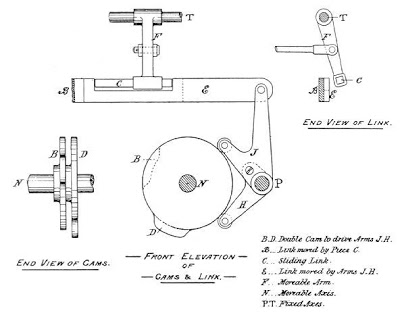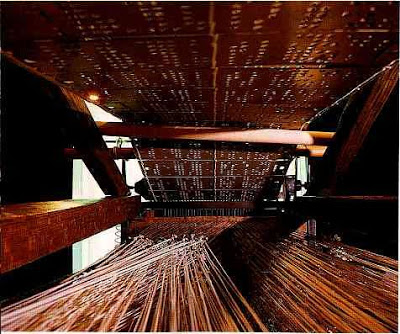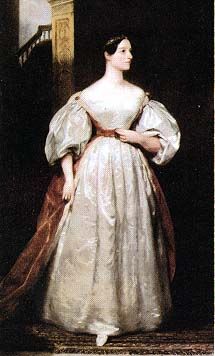Babbage analytical machine. Part Three - Final
 (First I advise you to read the first and second parts of the article.)
(First I advise you to read the first and second parts of the article.)For the first time, the difference machine by Charles Babbage allowed us to automate the process of computing and produce it to some extent without human intervention. As it was said in the previous part, to calculate the functions of the logarithm type, trigonometric functions and others, they had to be divided into sections, each of which was represented by its own polynomial, and only then it was possible to calculate the function values for this section. Moving from one polynomial to another, the machine operator had to manually enter all the initial values of the registers. In addition, the machine allowed only the addition operation, which was not much even by the standards of the 19th century.
Thinking over this problem, Babbage came to the conclusion that it is possible to build such a machine that would itself change the values of the source registers depending on the value of the result. That is, she could manage the calculation process herself. In the future, developing this idea, Babbage came to the idea not just to make a machine that would tabulate the function fully automatically, but to create a machine that would allow to solve the entire class of computational problems. To do this, the algorithm of such a machine must not be rigidly sewn into its design, but must be set from the outside, and the machine itself must be able to perform all the arithmetic operations, as well as manage the progress of the calculations. New computer Babbage called Analytical.
')
The main parts of the Analytical machine were:
1. "warehouse" - a device for storing numbers, that is, memory in modern terminology;
2. “Mill” - devices for performing arithmetic operations (Arithmetic device);
3. The device controlling the operations of the machine;
4. Input and output devices;

(The element of the "mill". Figure by Henry Babbage. Source )
In such an architecture, it is not difficult to see the prototype of a modern computer with its memory, processor (mill + control device) and input / output devices.
The “data bus” between the ALU and memory was a set of racks. The memory should have been a thousand numbers of 50 decimal places. For a number of 50 decimal digits with a sign, 168 bits are needed, that is, the amount of RAM was slightly more than twenty kilobytes. For comparison, I advise here to see the amount of RAM of the first computers.
As it was said in the previous part, while working on an analytical machine, Babbage came up with an original preliminary transfer scheme. It is worth saying that before that he had thought over more than twenty options for the execution of a sequential transfer scheme, before realizing that a completely different principle is needed to dramatically speed up the process.
As in the differential machine, the registers that store the numbers were gear wheels. The number sign was set by a separate gear wheel. If this wheel displayed an even number, then it was interpreted as a positive sign, otherwise as negative.
The multiplication and division operations were to be implemented as successive additions or subtractions.
The estimated time to perform operations was one second for addition and subtraction and one minute for multiplication and division, which is not so bad for the 19th century.
To input the data into the memory and control of the machine, Babbage decided to use punch cards. At that time, they already existed for decades, and were invented by Jacquard Joseph-Marie to control the pattern of the automated loom.
The analytical machine used two mechanisms with punched cards - one mechanism specified the operations that the mill had to perform, the second controlled the transfer of data between the “mill” and the “warehouse”.

(Loom with Jacquard cards. Source )
During the stay of Babbage in Italy, a metamatist, Professor Mosotti, turned to him. “He noted that he was now quite ready to believe in the ability of the mechanism to master arithmetic and even algebraic relations to any necessary degree. But he added that he cannot understand how a machine can make a choice, which is often necessary in an analytical study (that is, during the calculation process) when two or more ways are presented, especially in the case when the correct way, as is often the case, is unknown until the previous calculations have been done. ” For this case, the Analytical Machine provided for the possibility of organizing conditional execution and cycles. To do this, the transfer mechanism of the last digit controlled the movement of punched cards and could force this mechanism to repeat the action or skip it.
Output devices made it possible to print to the result of the machine’s calculations in one or two copies, to reproduce as a stereotypical imprint, or to punch the result on punched cards.
Working on the analytical machine, Babbage made more than 200 drawings of its various components and about 30 variants of the layout of the machine. However, the size of the idea, and the complex nature of the inventor, delayed the birth of his inventions for a good hundred years. If you look at the difference machine, which Babbage planned was to tabulate functions with constant seventh differences up to the 20th digit, the machine closest in capabilities appeared in 1934 — it tabulated functions with seventh-order constant differences and up to 13 digits . What can we say about the gigantic possibilities of the conceived analytical machine ...

(Part of the printing mechanism of the machine. Source )
After the death of Charles Babbage, his son, Henry, took up the analytical machine, deciding to focus on two nodes - the "mill" and the printer. In 1888, the machine node data was ready, which could calculate and print the product on the numbers of the natural series with 29 characters. When calculating the 32nd member, the machine gave an incorrect result due to a failure in the transfer mechanism. For the rest of his life, Henry continued to work on his father’s analytic machine, and also popularized the ideas of computers.
Despite the fact that Babbage had written many books and articles in his life, he did not create a detailed statement of the principles of operation of the difference and analytical machines, since he considered the creation of machines to be more important than their description. A detailed description of the differential machine was given by Dionysius Lardner, and the analytical machine was described in an article by Luigi Frederigo Menabrea. It was this article that led to the birth of the first program in the world and the first programmer. Ada Augusta Lovelace, the daughter of the poet Byron, has the honor to bear such a title. Charles Babbage was familiar with the family of a young talented girl and strongly encouraged her craving for science. One day, Ada became interested in Babbage's computers and began to translate Menabrea's article. Working on the translation, Ada supplemented it with her comments, examples of the practical use of machines, and also compiled a “program” for calculating Bernoulli numbers. The name of Ada was immortalized in the name of one of the programming languages - Ada (Ada). I will not go deeper into the biography of Ada, because This topic has already been opened on Habré.

(Ada Augusta Lovelace. Source )
The fate of Charles Babbage was no less complicated than the fate of his computers. The attitude of contemporaries to this scientist changed over time from genius to eccentric, and even to the inventor, damaged by reason on the basis of computers. During his life, he created a large number of various inventions, such as a speedometer, a dynamometer, came up with a single postal rate and so on. The president of the Royal Society, Lord Ross, wrote that "Babbage only with its inventions in the field of mechanical engineering completely reimbursed the funds that the government invested in the construction of its differential machine."
The idea that was born in the nineteenth century and became a reality in the twentieth century made a revolution not only in science, but also in our daily life. Babbage's life, the history of his computers is the clearest example of how far-sighted and stubborn a genius can be, and how thorny and long the path of creation can be.
PS: Anyone who is interested in mechanical computers, their history of creation, description of the design and principles of operation and the emergence of their electronic counterparts recommend finding and reading the book "From Abacus to the Computer" by R. S. Guter and Yu. L. Polunova 1981 edition .
Source: https://habr.com/ru/post/82929/
All Articles